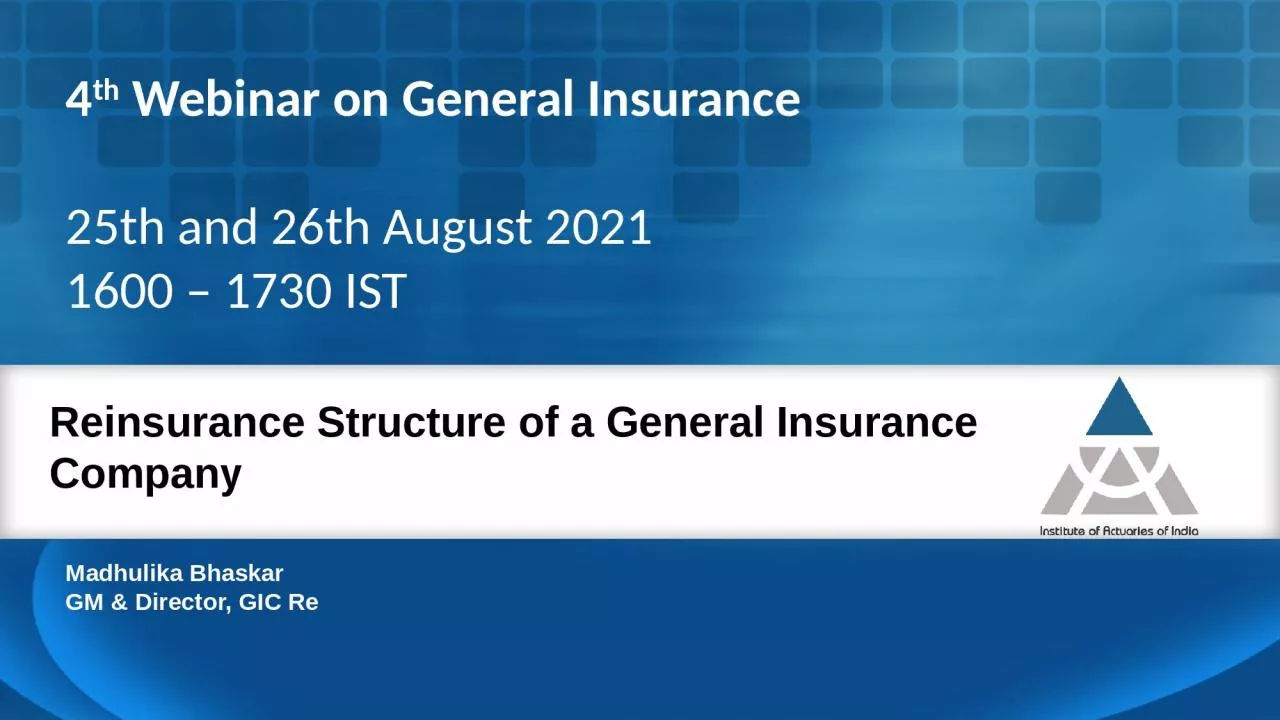

General Insurance Company Madhulika Bhaskar GM amp Director GIC Re 4 th Webinar on General Insurance 25th and 26th August 2021 1600 1730 IST wwwactuariesindiaorg wwwactuariesindiaorg ID: 1029795
Download Presentation The PPT/PDF document "Reinsurance Structure of a" is the property of its rightful owner. Permission is granted to download and print the materials on this web site for personal, non-commercial use only, and to display it on your personal computer provided you do not modify the materials and that you retain all copyright notices contained in the materials. By downloading content from our website, you accept the terms of this agreement.
1. Reinsurance Structure of a General Insurance CompanyMadhulika BhaskarGM & Director, GIC Re4th Webinar on General Insurance25th and 26th August 20211600 – 1730 IST
2. www.actuariesindia.org
3. www.actuariesindia.org
4. Treaty Structure of a GI Co - multiple LOBsDepends on cedantQuota Share for New Class and New CompanyQuota cum Surplus used to make Gross retentions meaningfulSurplus for established portfolio and CompanyNew Cos need upfront automatic capacityXOL for high severity, low frequencyStop Loss for high volatilityLaw of the land- Mandatory quota sharewww.actuariesindia.org
5. Multi Year Multi Line ( MYML) Diversified portfolioDifference in behavior of classesDifference in tail Flexibility in setting exposure Longer term to recoup losses Total capacity usually fixed Fine tuning of capacity within linesReduces volatility Better overall experienceCapital conservation www.actuariesindia.org
6. Performance assessment of treatiesUsual metricsLoss ratios, by sub class, FY, UY wise, ULRNet result . Combined ratioSliding scale /profit commission vs loss ratioBreach of loss caps / limits. Cash flow assessmentRisk assessmentEffectiveness of SI / PML basisBlind spiralsPer event CAT Per event riskwww.actuariesindia.org
7. Performance assessment contd….Performance Gross / Net of retrocessionAccumulationRisk accumulation Geographical Line of businessLong term performance Return on investment / capital Years to recoupExpected Reinsurer DeficitCapital assessment www.actuariesindia.org
8. Factors affecting treaty renewal Reinsured and Reinsurer are on opposite sides of the table.Finding a win-win solution – challengingFactors affecting decision:Capacity / Protection requirementPast performanceHard/Soft marketManagement decisionLaw of the landOffered terms and conditions (premium, loss corridor, commission, attachment point, cover limits….) Solvency positionAccumulation/Exposure controlwww.actuariesindia.org
9. RI pricing – Reinsurer’s perspectiveBased on types of contract ProportionalNot much scope in pricingLoss caps / corridorsSliding scale / profit commission XOL Experience / Exposure based, attachment points, limitsStop LossActuarial pricing. Attachment points, limits Expected reinsurer deficit-based pricingCapital assessment based www.actuariesindia.org
10. CAT modellingAgencies – Risk Management Solutions (RMS), AIR Worldwide (AIR) and EQECATVarious CATs modelled are EQ, Hurricane, Flood etc.Given the exposures, the models help understand the expected losses and in turn the protection programe sizeIt helps optimize the exposure It gives an indication on pricing adequacy.www.actuariesindia.org
11. Impact of Covid-19Health / Life portfolios impacted Delay in assessing Economic impact Exposed the loopholes in treaty wordingsClaims Judgement delivered in countries like SA, still in reserve state in London BI claims paid without associated Material Damage claims Explicit reserving provisions made in books of accountsStill impact is not fully evident in Indiawww.actuariesindia.org
12. Entry of FRB’s10 FRBs +1 Lloyds branch registered in India Total reinsurance written premium INR 63,712 Cr* Biggest attraction in India 64VB (cash and carry)Growing market – huge potentialIndian reinsurance market is largely proportionalFRB’s write largely non-proportional, hence GIC still the market leader with 80.09% market share*FRBs support specialized lines e.g., Cyber insuranceNot much product innovation yet in General RI mkt.*IRDAI annual report 2019-20 Page 32www.actuariesindia.org
13. www.actuariesindia.orgAvailability of RI capacity is a function of profitability, this is eminently cyclical in natureSOFT MARKET: In absence of cat losses, if reinsurers make profits, then more reinsurers enter the market with capacity or existing reinsurers increase their capacity. This leads to a situation of more capacity less business and leads to fall in the rates and reinsurance becomes cheaper HARD MARKET: Lesser premium to service more risks, losses in the subsequent years could put reinsurers to hard situation and lead to exit of some of the reinsurers and capacity. This will harden the market and leads to increase in rates.Hard & Soft Market
14. Hard & Soft MarketReinsurance markets are Dynamic in natureEntry of Alternate Third-Party Capital (CAT Bonds, ILW (Industrial Loss Warranty), ILS (Insurance Linked Security), Side Cars, Hedge funds, Pension funds and other collateralised structures.Above distorts the cyclical nature of Reinsurance Mkt.Impact different for different lines of business as some niche mkts support specialized classes.Impacted by global events Catastrophes Airline crashCovid-19 judgementswww.actuariesindia.org
15. Questions ? www.actuariesindia.org
16. Thank You www.actuariesindia.org
17. Forms of Reinsurance TreatyProportionalNon-ProportionalQuota ShareSurplusExcess of Loss(XOL)Stop lossRisk basisOccurrence basisBalance sheetProtectionSharing of lossesEqual sharing ofpremium and claims(As Ratio)Equal sharing ofpremium and claims(As %)Capacity ProviderSharing of Risk